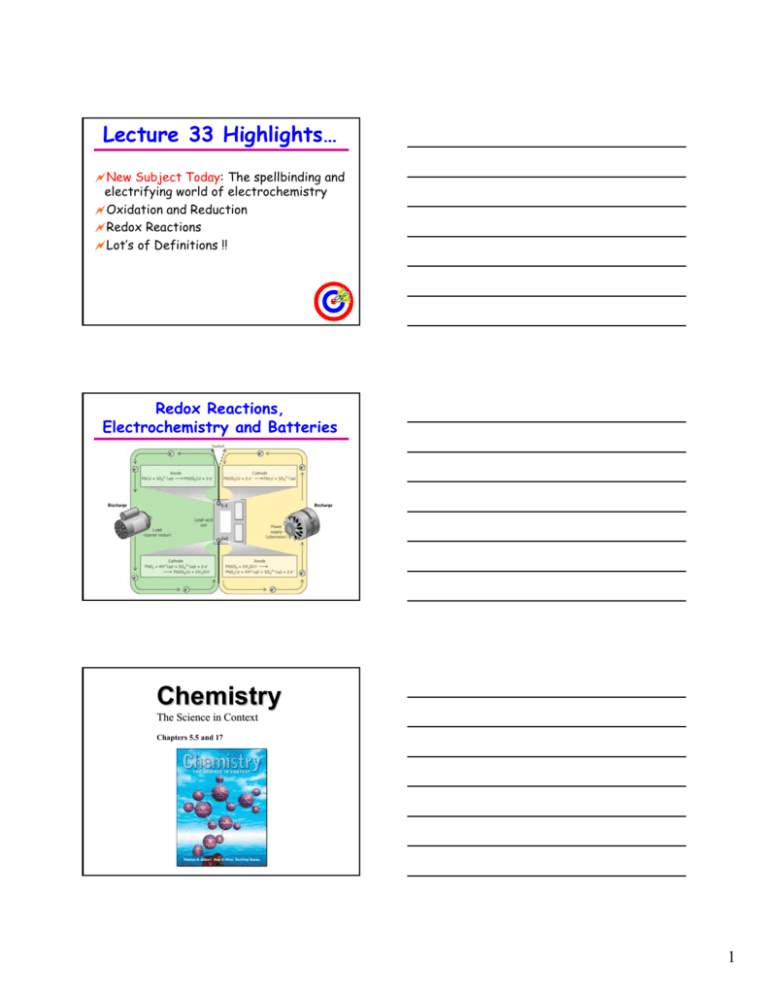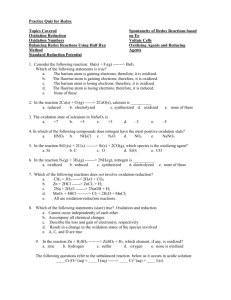Chemistry
advertisement

Lecture 33 Highlights… aNew Subject Today: The spellbinding and electrifying world of electrochemistry aOxidation and Reduction aRedox Reactions aLot’s of Definitions !! Redox Reactions, Electrochemistry and Batteries Chemistry The Science in Context Chapters 5.5 and 17 1 Redox Reactions Definition: Reactions where there is a simultaneous transfer of electrons from one chemical species to another…. 9Oxidation: Loss of electrons 9Reduction: Gain of electrons 9Half Reactions: Two reactions which combine to give an overall “Redox” reaction Oxidation 9Defined as: • Loss of electrons (LEO) • Gain of Oxygen • Loss of Hydrogen The last two definitions are useful in organic chemistry and combustion reactions. Oxidation – Loss of Electrons 9 For example, the reaction of sodium metal with chlorine gas to form sodium chloride (NaCl). Sodium loses an electron as follows: Na(s) Æ Na+ + eCl2 (g) + 2e- → 2 Cl- When sodium metal loses the electron, chemists say that the sodium metal has been oxidized to the sodium cation (positively charged ion.) 2 Oxidation – Gain of Oxygen 9 Sometimes, it is more obvious that oxygen has been gained instead of electrons in going from reactants to products. Such is the case of combustion/burning of coal and rusting of a metal: C(s) + O2(g) Æ CO2(g) 2Fe(s) + 3O2(g) Æ 2Fe2O3(s) Oxidation – Loss of Hydrogen 9In other reactions, oxidation can best be seen as the loss of hydrogen: CH3OH(l) Æ CH2O(l) + H2(g) In going from methanol to formaldehyde, the compound went from having four hydrogen atoms to having two hydrogen atoms. Reduction 9Defined as: • Gain of electrons (GER) • Loss of Oxygen • Gain of Hydrogen 3 Reduction – Gain of Electrons 9Reduction is often seen as the gain of electrons: Ag+ + e- Æ Ag(s) When the silver cation gains the electron, chemists say that it has been reduced to silver metal. Reduction – Loss of Oxygen 9Sometimes, it is more obvious that oxygen has been lost in going from reactants to products: Fe2O3(s) + 3CO(g) Æ 2Fe(s) + 3CO2(g) The iron lost oxygen, so chemists say that the iron ion has been reduced. Reduction – Gain of Hydrogen 9In other reactions, oxidation can best be seen as the gain of hydrogen: CO(g) + 2H2(g) Æ CH3OH(l) In going from carbon monoxide to methanol, the compound gained four hydrogen atoms. 4 Oxidation - Reduction 9Neither can take place without the other. Consider the reaction between zinc metal and an aqueous copper (II) sulfate solution: Zn(s) + Cu2+ Æ Zn2+ + Cu(s) 9The overall reaction may be decomposed into two half-reactions: Zn(s) Æ Zn2+ + 2e- (oxidation – loss of electrons) Cu2+ + 2e- Æ Cu(s) (reduction – gain of electrons) REDOX Agents 9The Oxidizing Agent is Reduced. 9The Reducing Agent is Oxidized. Zn(s) Æ Zn2+ + 2e- (reducing agent – it is oxidized) Cu2+ + 2e- Æ Cu(s) (oxidizing agent – it is reduced) Keeping Track of Electrons …. Bookkeeping by Oxidation Numbers 9The oxidation number of any element is zero including diatomic elements (H2). 9In a simple compound the oxidation number of an atom is the same as its charge. NaCl: Na oxidation number = +1, -1 for Cl In H2S: H = +1, S = -2 In general, alkaline metals are +1 (IA family), alkaline earths are +2 (IIA family) 9The sum of the oxidation numbers in a neutral compound = zero. 5 Oxidation Numbers-II 9 O is usually -2 except “peroxides” (O is -1 in H2O2, for example). H is +1 bonded to nonmetals, -1 bonded to metals (in metal hydrides, NaH). 9 In a covalent compound the oxidation number of an atom indicates the number of electrons partially lost or gained. 9 The sum of the oxidation numbers in a polyatomic ion = its charge. Ex. chromate: CrO42- : Cr = +6, O = 4 x -2; Net = -2 Or, H3O+ : H = 3 x +1, O = -2; Net =+1 9 Cl, Br and I are usually -1 (F is always -1), unless they are combined with oxygen (Cl is +1 in ClO-). Oxidation Numbers-III 9So, in an electrochemical reaction, if an atom’s oxidation number increases (say from 0 to +2 or from +2 to +3), then it has been oxidized. 9If an atom’s oxidation number decreases after a reaction, then it has been reduced. • Example: Mg(s) + FeCl2 (aq) → MgCl2(aq) + Fe (s) • Ox. Num. = 0 +2, -2 +2, -2 0 • Mg is oxidized, Fe is reduced and chlorine is a socalled spectator ion ! • Why not the reverse reaction ? Thanks.. Brown, LeMay, Bursten 6 Whiteboard Problems Balancing Redox Equations Al(s) + HCl(aq) Æ AlCl3(aq) + H2(g) 1. 2. 3. Find and write the half-reactions: Al Æ Al3+ (it is oxidized – loses electrons) H+ Æ H2 (it is reduced – gains electrons) Balance the atoms in the half-reactions: Al Æ Al3+ 2H+ Æ H2 Balance the charges in the half-reactions by adding electrons: Al Æ Al3+ + 3e2H+ + 2e- Æ H2 Balancing Redox Equations 4. 5. 6. Make the number of electrons lost = the number gained by multiplying one or both half-reactions by a stoichiometric factor: 2 x (Al Æ Al3+ + 3e-) 3 x (2H+ + 2e- Æ H2) Add the half-reactions to arrive at the balanced net ionic equation 2Al Æ 2Al3+ + 6e6H+ + 6e- Æ 3H2 6H+ + 2Al Æ 2Al3+ + 3H2 Add the spectator ion back in and associate the ion to arrive at the balanced molecular equation 6H+ + 2Al Æ 2Al3+ + 3H2 6ClÆ 6Cl2Al(s) + 6HCl(aq) Æ 2AlCl3(aq) + 3H2(g) 7






